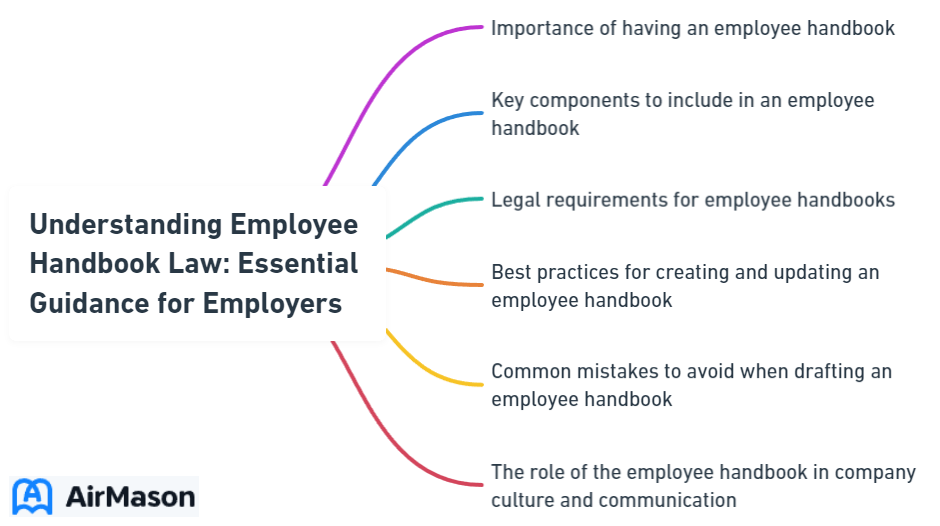
Creating a legally compliant employee handbook is more than just a procedural task; it’s a legal imperative. When searching for ‘employee handbook law’, you’re looking for specific guidelines to ensure your handbook meets both federal and state legal standards. This article dives directly into the details of these requirements and simplifies the process for you, providing concrete steps to avoid legal pitfalls while crafting an effective employee handbook.
Key Takeaways
- Employee handbooks must encompass critical federal laws like FLSA, FMLA, EEOC guidelines, OSHA regulations, and articulate state-specific employment laws, ensuring comprehensive compliance with national and state-level employment legislation.
- Employers should regularly update and effectively communicate changes in the employee handbook to reflect the latest company policies and legal standards, ensuring employees are well-informed and acknowledging their understanding.
- Legal review, clear language, and avoidance of unintended contractual language are essential when crafting or updating employee handbooks to mitigate legal risks, maintain an at-will employment relationship, and ensure clarity and accessibility for all employees.
Employee Handbook Amendments
Employee Handbook Amendments are crucial documents that outline changes, updates, or additions to the existing company policies and procedures. These amendments serve to keep employees informed about any modifications in their rights, responsibilities, and benefits within the organization. It is imperative for both employers and employees to thoroughly review and understand these amendments to ensure compliance and alignment with company standards. Effective communication channels should be established to disseminate these updates promptly and efficiently across all levels of the organization. Additionally, employees should be encouraged to provide feedback or seek clarification on any aspect of the amendments to promote transparency and clarity in the workplace. Regular reviews and revisions of the employee handbook amendments are essential to adapt to evolving legal requirements, industry standards, and organizational needs.
Navigating Federal Employment Laws in Your Employee Handbook

Employee handbooks serve as a vital communication tool between employers and employees, outlining the company’s policies, benefits, and expectations. A comprehensive employee handbook should include critical federal laws such as:
- Fair Labor Standards Act (FLSA)
- Family and Medical Leave Act (FMLA)
- Equal Employment Opportunity Commission (EEOC) guidelines
- Occupational Safety and Health Administration (OSHA) regulations
These laws, including the National Labor Relations Act, necessitate the communication of certain rights and protections to employees, facilitating their understanding of entitlements and obligations.
The FLSA and Overtime Rules
The Fair Labor Standards Act (FLSA) is a cornerstone of employee rights that governs minimum wage and overtime pay for non-exempt employees. The FLSA mandates that covered non-exempt employees are entitled to a federal minimum wage and overtime pay at a rate of one-and-a-half times the regular pay after 40 hours of work in a workweek.
Additionally, the FLSA restricts the employment of minors in roles deemed hazardous or potentially detrimental to their health or development.

FMLA Provisions for Medical Leave
The Family and Medical Leave Act (FMLA) is another critical legislation that should be incorporated into your employee handbook. This act entitles eligible employees to take up to 12 weeks of unpaid, job-protected leave for specified family and medical reasons, including up to 26 workweeks of military caregiver leave for eligible employees caring for covered service members and up to 12 workweeks of qualifying exigency leave related to a family member’s foreign deployment.
It’s worth noting that employers are obligated to maintain the same group health insurance coverage for an employee on FMLA leave.
Upholding EEOC Standards

The Equal Employment Opportunity Commission (EEOC) guidelines are another fundamental federal law to be covered in the handbook. These guidelines demand an explicit equal employment opportunity statement in your handbook, reflecting your company’s commitment to an environment free from harassment and discrimination based on:
- race
- color
- religion
- sex
- national origin
- age
- disability
- genetic information
Ensuring a Safe Workplace with OSHA

Finally, the Occupational Safety and Health Administration (OSHA) regulations ensure a safe and healthy work environment. Employers are required to adhere to these regulations and document their compliance in the employee handbook. This should outline the employer’s plans for maintaining a safe work environment, including safety and security policies and protocols for emergencies.
Employee Handbook Requirements by State
Employee handbook requirements by state vary significantly from state to state, with each jurisdiction having its own set of regulations and guidelines that employers must adhere to. It is crucial for businesses to familiarize themselves with the specific requirements in their state to ensure compliance with labor laws and regulations. From policies on at-will employment and anti-discrimination to wage and hour laws, employee handbooks must address a wide range of legal and procedural matters. Employers may also need to consider industry-specific regulations and local ordinances when drafting or updating their employee handbooks. Failure to meet these requirements can result in legal consequences and penalties for non-compliance. Therefore, consulting with legal counsel or HR professionals familiar with the laws in your state is essential to create a comprehensive and compliant employee handbook.
State-Specific Employment Law Considerations
While federal laws lay a national framework, federal and state laws, including state-specific employment laws, add another dimension of complexity. These laws vary across states, necessitating employers to navigate through different regulations, such as:
- Paid sick leave laws
- Jury duty obligations
- Minimum wage requirements
- Overtime laws
- Family and medical leave laws
Understanding and complying with these state-specific laws is crucial for employers to ensure they are meeting their legal obligations.
For employers operating across state lines, a thorough grasp of the diverse legal landscape is required.
Complying with State Wage Laws
One of the critical state-specific laws employers must adhere to is the minimum wage law. Certain states have their own minimum wage laws that are higher than the federal minimum wage of $7.25 per hour. As such, employers must comply with the state-specific laws, which might necessitate higher wage payments.
Localized Leave and Benefits
Sick leave laws and benefits vary by state. These laws outline guidelines for paid leave during short-term illnesses and may even extend leave options beyond the federal FMLA. Hence, incorporating such state-specific paid time off and sick leave policies in your employee handbook is essential.
Crafting a Legally Compliant Employee Handbook

Crafting a legally compliant employee handbook involves more than just stating the rules. The handbook should:
- Be easy to read
- Avoid legal jargon
- Contain summarized and current statements of each policy
- Ensure all employees understand the company’s expectations and practices.
To avoid the handbook being misconstrued as a binding employment agreement, it should include a clear disclaimer, be reviewed by legal counsel, and maintain the employment-at-will status.
Defining At-Will Employment
At-will employment is a type of employment relationship where either the employer or the employee can terminate the employment at any time, with or without cause, and with or without notice. It’s important to explicitly state this in your handbook and all legal documents like confidentiality agreements.
This ensures clarity of the employment relationship and safeguards against potential legal complications.
Avoiding Unintended Contracts
While ensuring clarity and compliance, it’s also crucial to avoid unintended contracts. This can be achieved by:
- Including disclaimers that clearly state the at-will nature of employment
- Using clear and direct language
- Avoiding terms that could imply contractual obligations.
Remember to have legal counsel review the employee handbook to ensure it does not inadvertently create a contractual obligation.
Updating and Communicating Policies Effectively
An employee handbook is not a static document. It’s a dynamic guide that should evolve with changes in your company and laws. Regular updates to the employee handbook help maintain consistency in workplace practices and ensure that it remains a relevant and useful resource for employees. But updating alone isn’t enough. The changes need to be effectively communicated to the employees and their understanding should be documented and stored.
The Onboarding Process
The employee handbook is pivotal in the onboarding process, offering new employees detailed information about key policies and procedures. Whether in printed form during orientation sessions or electronically via the company’s internal systems, the handbook should be readily available to the new hires.
Furthermore, new employees should be required to acknowledge that they have received and understand the contents of the employee handbook, and this acknowledgment should be documented and stored in their personnel file.
Regular Review and Revision
The employee handbook should be seen as a dynamic document, subject to necessary amendments and updates. Regular review and updating of company policies are crucial to ensure that the policies and procedures align with company practices and legal requirements. This ensures employees always have access to the most current information and helps maintain the relevance and accuracy of the handbook.
Changes in laws, company growth, or shifts in mission, vision, values, or culture can necessitate amendments to the handbook. Establishing an internal review standard, such as every two years, can ensure thoroughness and clarity. After updating, the handbook should be re-issued to employees, with changes highlighted, and acknowledgment of receipt and understanding should be recorded.
Creating an Inclusive Work Environment

Given today’s diverse workforce, the importance of fostering an inclusive work environment cannot be overstated. An employee handbook can play a significant role in this by addressing harassment, discrimination, and disability-related policies. Your anti-harassment policy should articulate a clear definition of harassment, provide examples of prohibited conduct, and apply to everyone within the organization. It should also address online and remote harassment, including digital communications, to maintain inclusivity in remote work situations.
Furthermore, the handbook must provide a detailed procedure for:
- Reporting harassment
- Conducting confidential investigations
- Taking appropriate disciplinary action
- Following up post-investigation.
- In addition, it’s vital to address disability-related policies, including accommodations, and to set up a process for disability discrimination complaints, contributing to an inclusive work environment.
Employee Handbook Best Practices
Having explored the complexities of legal requirements, it’s now time to turn our attention to some best practices. An effective employee handbook should:
- Mirror the company’s mission, vision, and values
- Serve to welcome new employees while strengthening company culture
- Ensure that the handbook is accessible in printed or digital form
- Avoid overwhelming content and legal jargon
- Facilitate employee understanding and engagement with the company’s policies
Furthermore, clearly outlining workplace expectations, including work schedules, punctuality, and disciplinary processes, reduces the risk of misunderstandings and disciplinary issues. Consistency in workplace practices and the relevance of the employee handbook as a resource are maintained through regular updates.
Structuring Your Handbook
Structure plays a significant role in the effectiveness of an employee handbook. Before writing, establish the range of policies needed, such as conduct guidelines, performance expectations, and legal compliances, making sure to avoid redundant information. Present the handbook in a sequence that flows from general to specific, aiding in logical understanding and navigation.
Group similar topics together within the handbook to create coherent sections that are easier for employees to consult. Write the content in clear, concise language to ensure all employees, regardless of background, can easily comprehend the policies.
Clarity and Accessibility
To enhance the clarity and accessibility of your employee handbook, consider the following tips:
- Use headings, subheadings, and bullet points to organize information.
- Include real-life examples or scenarios to illustrate policy applications.
- Enhance the handbook with visual design that follows company branding.
- Incorporate multimedia elements to make it more engaging and easier to navigate.
- Ensure the digital employee handbook is ADA compliant and accessible to those with visual or hearing impairments.
By implementing these strategies, you can create a more user-friendly and inclusive employee handbook.
Finally, keep the handbook readily available to all employees by providing copies in common areas such as break rooms, an intranet, or physical copies upon request.
Non-Disclosure and Confidentiality
In the corporate world, confidentiality is paramount. Confidentiality agreements should clearly define what is considered confidential information to ensure employees understand what is required of them. Employees must commit to maintaining the confidentiality of specific information as defined in the agreements to protect the company’s proprietary assets.
Importantly, confidentiality obligations must be upheld by the employee even after the termination of employment, and any confidential material must be returned to the employer.
Legal Pitfalls to Avoid in Employee Handbooks
While employee handbooks serve as a crucial tool, they might also harbor potential legal pitfalls. Legal review of employee handbook updates is imperative to maintain compliance and prevent the handbook from being misconstrued as an implied contract. The at-will employment presumption in employee handbooks can be overridden by contracts or subjected to common law exceptions, potentially leading to claims such as wrongful termination. To enforce confidentiality provisions effectively, employers should have employees sign separate agreements, as those simply included in handbooks may not be considered binding contracts.
Failure to adhere to labor regulations, as outlined in the handbook, can result in costly employment lawsuits. It’s thus crucial to ensure that your handbook is legally sound and aligns with both federal and state employment laws.
Menards Employee Handbook
The Menards Employee Handbook serves as a comprehensive guide for all employees, outlining company policies, procedures, and expectations. It covers a wide range of topics, including workplace conduct, safety protocols, benefits eligibility, and disciplinary procedures. Employees are required to familiarize themselves with the contents of the handbook upon joining the company and adhere to its guidelines throughout their employment. The handbook serves as a valuable resource for both new hires and seasoned employees, ensuring consistency and compliance across the organization.
Summary
Crafting an effective, legally compliant employee handbook is crucial to communicate your company’s policies, culture, and expectations to your employees. It helps navigate the complex landscape of federal and state employment laws, ensuring the rights and protections of your employees. Regular updates and effective communication of these updates are integral to maintaining compliance and relevance. Adopting best practices, creating an inclusive work environment, and avoiding legal pitfalls will ensure that your employee handbook serves as a valuable resource for both your company and your employees.
Frequently Asked Questions
Is an employee handbook legally binding?
No, an employee handbook is not legally binding unless it explicitly states that it is or contains specific contractual promises that imply mutual obligations. Always review your employee handbook carefully to understand its legal implications.
Is it mandatory to have an employee handbook?
No, it is not mandatory to have an employee handbook, but it is important to provide employees with essential information regarding their rights and benefits as required by state and federal laws.
What happens if a company doesn t have an employee handbook?
Without an employee handbook, managers and employees will have to rely on the company’s “institutional memory” to ensure that policies are consistently applied. However, codifying policies in an official handbook can help make them more important and likely to be followed.
What is the purpose of including federal laws in the employee handbook?
The purpose of including federal laws in the employee handbook is to ensure that employees are aware of their rights and obligations, as mandated by laws such as the FLSA, FMLA, EEOC guidelines, and OSHA regulations. These laws provide certain rights and protections for employees.
How does state-specific employment law affect the employee handbook?
State-specific employment laws add complexity to the employee handbook, requiring businesses operating across multiple states to navigate different regulations such as paid sick leave and jury duty obligations for each state.
Important Disclaimer:
Please be aware that the content on this page has been generated by using artificial intelligence language models and may contain errors, inconsistencies, or outdated information. It is provided as-is without any warranties or guarantees of accuracy.
We strongly recommend using this content as a starting point for further research. We disclaim any liability for damages or losses resulting from the use or reliance on this content.